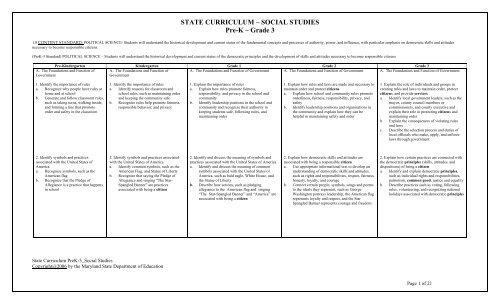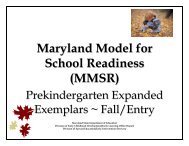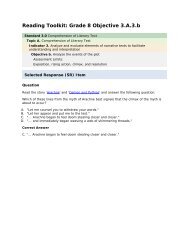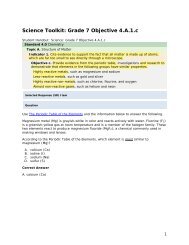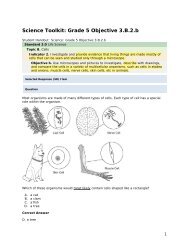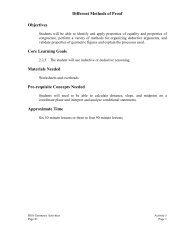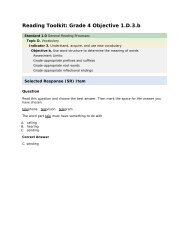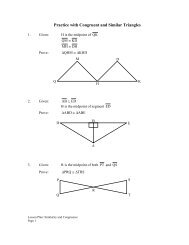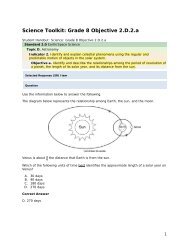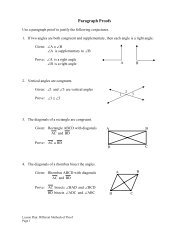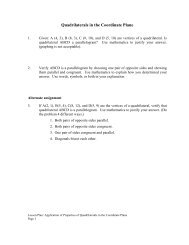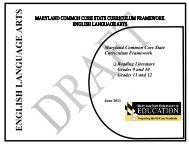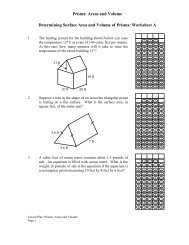Maryland State Curriculum - mdk12
Maryland State Curriculum - mdk12
Maryland State Curriculum - mdk12
- TAGS
- maryland
- curriculum
- mdk12.org
You also want an ePaper? Increase the reach of your titles
YUMPU automatically turns print PDFs into web optimized ePapers that Google loves.
<strong>State</strong> <strong>Curriculum</strong> PreK-3_Social Studies<br />
Copyright@2006 by the <strong>Maryland</strong> <strong>State</strong> Department of Education<br />
STATE CURRICULUM – SOCIAL STUDIES<br />
Pre-K – Grade 3<br />
1.0 CONTENT STANDARD: POLITICAL SCIENCE- Students will understand the historical development and current status of the fundamental concepts and processes of authority, power, and influence, with particular emphasis on democratic skills and attitudes<br />
necessary to become responsible citizens.<br />
(PreK-3 Standard) POLITICAL SCIENCE – Students will understand the historical development and current status of the democratic principles and the development of skills and attitudes necessary to become responsible citizens<br />
Pre-Kindergarten Kindergarten Grade 1 Grade 2 Grade 3<br />
A. The Foundations and Function of A. The Foundations and Function of<br />
A. The Foundations and Function of Government A. The Foundations and Function of Government A. The Foundations and Function of Government<br />
Government<br />
Government<br />
1. Identify the importance of rules<br />
a. Recognize why people have rules at<br />
home and at school<br />
b. Generate and follow classroom rules,<br />
such as taking turns, walking inside,<br />
and forming a line that promote<br />
order and safety in the classroom<br />
2. Identify symbols and practices<br />
associated with the United <strong>State</strong>s of<br />
America<br />
a. Recognize symbols, such as the<br />
American flag<br />
b. Recognize that the Pledge of<br />
Allegiance is a practice that happens<br />
in school<br />
1. Identify the importance of rules<br />
a. Identify reasons for classroom and<br />
school rules, such as maintaining order<br />
and keeping the community safe<br />
b. Recognize rules help promote fairness,<br />
responsible behavior, and privacy<br />
2. Identify symbols and practices associated<br />
with the United <strong>State</strong>s of America<br />
a. Identify common symbols, such as the<br />
American Flag, and Statue of Liberty<br />
b. Recognize that saying the Pledge of<br />
Allegiance and singing “The Star-<br />
Spangled Banner” are practices<br />
associated with being a citizen<br />
1. Explain the importance of rules<br />
a. Explain how rules promote fairness,<br />
responsibility, and privacy in the school and<br />
community<br />
b. Identify leadership positions in the school and<br />
community and recognize their authority in<br />
keeping students safe, following rules, and<br />
maintaining order<br />
2. Identify and discuss the meaning of symbols and<br />
practices associated with the United <strong>State</strong>s of America<br />
a. Identify and discuss the meaning of common<br />
symbols associated with the United <strong>State</strong>s of<br />
America, such as bald eagle, White House, and<br />
the Statue of Liberty<br />
b. Describe how actions, such as pledging<br />
allegiance to the American flag and singing<br />
“The Star-Spangled Banner” and “America” are<br />
associated with being a citizen<br />
1. Explain how rules and laws are made and necessary to<br />
maintain order and protect citizens<br />
a. Explain how school and community rules promote<br />
orderliness, fairness, responsibility, privacy, and<br />
safety<br />
b. Identify leadership positions and organizations in<br />
the community and explain how they can be<br />
helpful in maintaining safety and order<br />
2. Explain how democratic skills and attitudes are<br />
associated with being a responsible citizen<br />
a. Use appropriate informational text to develop an<br />
understanding of democratic skills and attitudes,<br />
such as rights and responsibilities, respect, fairness,<br />
honesty, loyalty, and courage<br />
b. Connect certain people, symbols, songs and poems<br />
to the ideals they represent, such as George<br />
Washington portrays leadership, the American flag<br />
represents loyalty and respect, and the Star<br />
Spangled Banner represents courage and freedom<br />
1. Explain the role of individuals and groups in<br />
creating rules and laws to maintain order, protect<br />
citizens, and provide services<br />
a. Identify local government leaders, such as the<br />
mayor, county council members or<br />
commissioners, and county executive and<br />
explain their role in protecting citizens and<br />
maintaining order<br />
b. Explain the consequences of violating rules<br />
and laws<br />
c. Describe the selection process and duties of<br />
local officials who make, apply, and enforce<br />
laws through government<br />
2. Explain how certain practices are connected with<br />
the democratic principles (skills, attitudes, and<br />
dispositions) of being a citizen<br />
a. Identify and explain democratic principles,<br />
such as individual rights and responsibilities,<br />
patriotism, common good, justice and equality<br />
b. Describe practices such as voting, following<br />
rules, volunteering, and recognizing national<br />
holidays associated with democratic principles<br />
Page 1 of 21
<strong>State</strong> <strong>Curriculum</strong> PreK-3_Social Studies<br />
Copyright@2006 by the <strong>Maryland</strong> <strong>State</strong> Department of Education<br />
STATE CURRICULUM – SOCIAL STUDIES<br />
Pre-K – Grade 3<br />
1.0 CONTENT STANDARD: POLITICAL SCIENCE- Students will understand the historical development and current status of the fundamental concepts and processes of authority, power, and influence, with particular emphasis on democratic skills and attitudes<br />
necessary to become responsible citizens.<br />
(PreK-3 Standard) POLITICAL SCIENCE – Students will understand the historical development and current status of the democratic principles and the development of skills and attitudes necessary to become responsible citizens<br />
Pre-Kindergarten Kindergarten Grade 1 Grade 2 Grade 3<br />
B. Individual and Group Participation in B. Individual and Group Participation in B. Individual and Group Participation in the B. Individual and Group Participation in the B. Individual and Group Participation in the Political System<br />
the Political System<br />
the Political System<br />
Political System<br />
Political System<br />
1. Recognize people important to the<br />
American political system<br />
a. Respond to informational text read<br />
aloud to develop an awareness of the<br />
contributions made by certain<br />
individuals that are remembered<br />
during the observance of national<br />
holidays and celebrations<br />
1. Identify people important to the<br />
American political system<br />
a. Identify the contributions of<br />
people, past and present, such as<br />
George Washington, Rosa Parks,<br />
and the current president<br />
b. Use informational text to identify<br />
and discuss the contributions of<br />
individuals recognized on national<br />
holidays, such as Martin Luther<br />
King, Jr. Day and Presidents’ Day<br />
1. Identify and describe people important to<br />
the American political system<br />
a. Describe the contributions of people,<br />
past and present, such as George<br />
Washington, Abraham Lincoln, Martin<br />
Luther King, Jr. and the current<br />
president<br />
b. Explain how contributions of people<br />
may be recognized with holidays and<br />
celebrations, such as Presidents' Day and<br />
Veterans’ Day<br />
1. Explain how contributions and events are<br />
important to the American political system<br />
a. Describe the contributions of local<br />
government leaders and current leaders of<br />
their school and community, such as county<br />
executives, county council or mayor, and city<br />
council<br />
b. Explain how contributions of people<br />
recognized in holidays, such as Memorial<br />
Day and Constitution Day, represent<br />
democratic beliefs and attitudes, that include<br />
rights and responsibilities, loyalty, respect,<br />
and courage<br />
1. Explain how people and events have contributed to the American<br />
political system.<br />
a. Describe the contributions of local government leaders such as<br />
county executives, county council, mayor and city council<br />
b. Describe the contributions of people who contributed to the common<br />
good of society<br />
2. Analyze the role of individual and group participation in creating a<br />
supportive community<br />
a. Explain the decision making process used to accomplish a<br />
community goal or solve a community problem<br />
b. Explain the roles and responsibilities of effective citizens in a<br />
political process<br />
c. Describe the actions of people who have made a positive difference<br />
in their community, such as community and civic leaders, and<br />
organizations<br />
Pre-Kindergarten Kindergarten Grade 1 Grade 2 Grade 3<br />
C. Protecting Rights and Maintaining<br />
Order<br />
C. Protecting Rights and Maintaining Order C. Protecting Rights and Maintaining Order C. Protecting Rights and Maintaining Order<br />
C. Protecting Rights and Maintaining Order<br />
1. Identify the roles, rights, and 1. Describe the roles, rights, and<br />
1. Describe the rights and responsibilities of 1. Describe the rights and responsibilities of being a 1.Explain the rights and responsibilities of being a member of the school<br />
responsibilities of being a member of responsibilities of being a member of the being a participating member of the family, participating member of the school and the<br />
and the community<br />
the family and school<br />
family and school<br />
school and neighborhood<br />
community<br />
a. Describe the responsibilities of being an effective citizen, such as<br />
a. Identify roles of family members a. Describe the roles, rights, and a. Identify the rights, responsibilities and a. Recognize and describe how making choices cleaning up your neighborhood, being informed, obeying rules and<br />
b. Identify the roles of members of responsibilities of family members choices that students have in the<br />
affects self, family, school, and community<br />
laws, participating in class decisions, and volunteering<br />
the school, such as principal, b. Describe the roles of members of the family, school, and neighborhood b. Identify concerns in the community, such as<br />
teacher, and nurse<br />
school, such as principal, crossing b. Demonstrate ways to work together to safety issues and pollution problems and ways<br />
c. Identify and discuss rights,<br />
guard, bus drivers, and teachers<br />
maintain a clean and safe home,<br />
to resolve these concerns<br />
responsibilities and choices in the c. Identify and describe rights, and<br />
school, and neighborhood<br />
classroom and family<br />
responsibilities n the classroom and<br />
family<br />
environment<br />
Page 2 of 21
<strong>State</strong> <strong>Curriculum</strong> PreK-3_Social Studies<br />
Copyright@2006 by the <strong>Maryland</strong> <strong>State</strong> Department of Education<br />
STATE CURRICULUM – SOCIAL STUDIES<br />
Pre-K – Grade 3<br />
2.0 CONTENT STANDARD: PEOPLES OF THE NATIONS AND WORLD –Student will understand the diversity and commonality, human interdependence, and global cooperation of the people of <strong>Maryland</strong>, the United <strong>State</strong>s, and the World through a multicultural and<br />
a historic perspective.<br />
(PreK-3 STANDARD) PEOPLES OF THE NATIONS AND WORLD -Students will understand how people in <strong>Maryland</strong>, the United <strong>State</strong>s and around the world are alike and different.<br />
Pre-Kindergarten Kindergarten Grade 1 Grade 2 Grade 3<br />
A. Elements of Culture<br />
A. Elements of Culture<br />
A. Elements of Culture<br />
A. Elements of Culture<br />
A. Elements of Culture<br />
1. Identify themselves as individuals and<br />
members of families that have the same<br />
human needs as others<br />
a. Identify the members of their<br />
families and the ways that they<br />
meet their human needs for food,<br />
clothing, shelter, and other<br />
commonalties, such as recreation,<br />
stories, and music<br />
b. Use personal experiences, stories,<br />
and electronic media to<br />
demonstrate understanding that all<br />
people need food, clothing, and<br />
shelter<br />
1. Identify similarities and differences in people’s<br />
characteristics, habits, and living patterns to describe<br />
how they meet the same human needs<br />
a. Use experiences, such as class trips, classroom<br />
visitors, stories, and electronic media, to give<br />
examples of different choices people make<br />
about meeting their human needs for food,<br />
clothing, shelter, and other commonalities, such<br />
as recreation, stories, and music<br />
b. Give examples of qualities, such as customs,<br />
interests, skills, and experiences that make<br />
individuals and families in their immediate<br />
environment unique<br />
1. Observe and describe ways that people of different<br />
cultural backgrounds meet human needs and contribute<br />
to the community<br />
a. Observe and describe ways people in their school<br />
and community meet human needs for food,<br />
clothing, shelter, and other commonalities, such as<br />
recreation, music, and stories<br />
b. Discuss and respect traditions and customs of<br />
families in the community<br />
1. Analyze elements of two different cultures and<br />
how each meets their human needs and contributes to<br />
the community<br />
a. Use fiction and non-fiction to compare the<br />
elements of two different cultures, and how<br />
they meet their human needs for food, shelter,<br />
and other commonalities such as recreation,<br />
music, and stories<br />
b. Explain ways people of different ages and/or<br />
cultural backgrounds can respect and help to<br />
pass on traditions and customs<br />
1. Analyze and describe elements of a multicultural<br />
setting<br />
a. Use fiction and non-fiction to compare the<br />
elements of several cultures and how they meet<br />
their human needs for clothing, food, shelter,<br />
recreation, education, stories, art, music, and<br />
language<br />
b. Explain how and why media, such as the<br />
internet, television, radio, and newspaper<br />
provide an opportunity to understand various<br />
perspectives about cultures<br />
Pre-Kindergarten Kindergarten Grade 1 Grade 2 Grade 3<br />
B. Cultural Diffusion<br />
B. Cultural Diffusion<br />
B. Cultural Diffusion<br />
B. Cultural Diffusion<br />
B. Cultural Diffusion<br />
1. Recognize that individuals and groups share and borrow<br />
from other cultures<br />
a. Identify how families choose to share and borrow<br />
traditions from other cultures<br />
1. Explain that individuals and groups share and<br />
borrow from other cultures to form a community<br />
a. Give examples of how families in the<br />
community share and borrow customs and<br />
traditions from other cultures<br />
1. Identify and describe how individuals and<br />
groups share and borrow from other cultures<br />
a. Use non-fiction texts to identify and discuss<br />
examples of how communities borrow and<br />
share from other cultures<br />
Page 3 of 21
<strong>State</strong> <strong>Curriculum</strong> PreK-3_Social Studies<br />
Copyright@2006 by the <strong>Maryland</strong> <strong>State</strong> Department of Education<br />
STATE CURRICULUM – SOCIAL STUDIES<br />
Pre-K – Grade 3<br />
2.0 CONTENT STANDARD: PEOPLES OF THE NATIONS AND WORLD –Student will understand the diversity and commonality, human interdependence, and global cooperation of the people of <strong>Maryland</strong>, the United <strong>State</strong>s, and the World through a multicultural and<br />
a historic perspective.<br />
(PreK-3 STANDARD) PEOPLES OF THE NATIONS AND WORLD -Students will understand how people in <strong>Maryland</strong>, the United <strong>State</strong>s and around the world are alike and different.<br />
Pre-Kindergarten Kindergarten Grade 1 Grade 2 Grade 3<br />
C. Conflict and Compromise<br />
C. Conflict and Compromise<br />
C. Conflict and Compromise<br />
C. Conflict, Cooperation and Compromise<br />
C. Conflict and Compromise<br />
1. Identify how groups of people interact<br />
a. Identify and demonstrate<br />
appropriate social skills, such as<br />
listening to others, settling<br />
disagreements, and taking turns<br />
that help people live, work and<br />
play together at home and in<br />
school<br />
1. Demonstrate how groups of people interact<br />
a. Identify, discuss, and demonstrate appropriate<br />
social skills, such as listening to the speaker,<br />
taking turns, settling disagreements, and<br />
reaching compromise at home and in school<br />
1. Explain how groups of people interact<br />
a. Describe, discuss, and demonstrate<br />
appropriate social skills necessary for<br />
working in a cooperative group, such as<br />
sharing concern, care, and respect among<br />
group members<br />
1. Analyze ways in which people interact<br />
a. Identify and demonstrate appropriate social skills<br />
necessary for working in a cooperative group,<br />
such as sharing concern, care, and respect among<br />
group members<br />
b. Analyze how different points of view in school<br />
situations may result in compromise or conflict.<br />
1. Analyze how groups of people interact<br />
a. Identify and demonstrate appropriate social skills<br />
necessary for working in a cooperative group<br />
such as sharing concern, compassion, and respect<br />
among group members<br />
b. Analyze how different points of view in school<br />
and community situations may result in<br />
compromise or conflict<br />
Page 4 of 21
<strong>State</strong> <strong>Curriculum</strong> PreK-3_Social Studies<br />
Copyright@2006 by the <strong>Maryland</strong> <strong>State</strong> Department of Education<br />
STATE CURRICULUM – SOCIAL STUDIES<br />
Pre-K – Grade 3<br />
3.0 CONTENT STANDARD: GEOGRAPHY – Students will use geographic concepts and processes to examine the role of culture, technology, and the environment in the location and distribution of human activities and spatial connections throughout time.<br />
(PreK-3 Standard) GEOGRAPHY – Students will use geographic concepts and processes to understand location and its relationship to human activities<br />
Pre-Kindergarten Kindergarten Grade 1 Grade 2 Grade 3<br />
A. Using Geographic Tools<br />
A. Using Geographic Tools<br />
A. Using Geographic Tools<br />
A. Using Geographic Tools<br />
A. Using Geographic Tools<br />
1. Recognize that a globe and maps are<br />
used to help people locate places<br />
a. Recognize that maps are models<br />
of places<br />
b. Recognize that a globe is a model<br />
of Earth<br />
c. Make maps by drawing, building<br />
with blocks, and playing with<br />
clay, puzzles, pictures, and<br />
photographs<br />
1. Identify and describe how a globe and maps<br />
can be used to help people locate places<br />
a. Describe a globe as a model of Earth<br />
showing land and water<br />
b. Describe how maps are models showing<br />
physical features and/or human features<br />
of places<br />
c. Identify a location by using terms such as<br />
near-far, above-below, and here-there<br />
d. Identify pictures and photographs that<br />
represent places on a map such as, a<br />
playground and a fire station<br />
1. Use geographic tools to locate and describe places on<br />
Earth<br />
a. Locate the continents and oceans using maps and a<br />
globe<br />
b. Use photographs and pictures to describe a place<br />
c. Identify a place using bird’s eye view<br />
d. Define map elements as parts of a map that make<br />
it easy to use<br />
e. Describe where places are located on a map using<br />
relative distance and direction, such as near-far,<br />
above-below and cardinal directions (north, south,<br />
east, and west)<br />
1. Use geographic tools to locate and describe places on<br />
Earth<br />
a. Identify the purpose and use of a globe and a<br />
variety of maps and atlases, such as school maps,<br />
neighborhood maps and simple atlases<br />
b. Identify and use map elements, such as title,<br />
compass rose, simple grid system, legend/key,<br />
date, and author to interpret a map<br />
c. Identify the equator, poles, seven continents, four<br />
oceans, and countries on a map and globe<br />
d. Describe a place using bird’s eye view, and satellite<br />
images, photographs, and pictures<br />
1. Use geographic tools to locate and construct<br />
meaning about places on Earth<br />
a. Describe the purposes of a variety of maps and<br />
atlases, such as transportation maps, physical<br />
maps, and political maps<br />
b. Construct and interpret maps by using elements,<br />
such as title, compass rose, simple grid system,<br />
scale, legend/key, date, and author<br />
c. Identify the location of communities, major<br />
cities in <strong>Maryland</strong>, and United <strong>State</strong>s using a<br />
globe, maps, and atlases<br />
Pre-Kindergarten Kindergarten Grade 1 Grade 2 Grade 3<br />
B. Geographic Characteristics of B. Geographic Characteristics of Places<br />
B. Geographic Characteristics of Places and Regions B. Geographic Characteristics of Places and Regions B. Geographic Characteristics of Places and Regions<br />
Places and Regions<br />
and Regions<br />
1. Recognize that places in the<br />
immediate environment have specific<br />
physical and human-made features<br />
a. Discuss that places have<br />
natural/physical features such as<br />
mountains, rivers, and hills<br />
b. Discuss that places have humanmade<br />
features, such as streets,<br />
buildings, and parks<br />
1. Describe places in the immediate environment<br />
using natural/physical and human-made<br />
features<br />
a. Recognize physical features as landforms<br />
and bodies of water using photographs and<br />
pictures<br />
b. Identify land forms, such as mountains and<br />
hills, and bodies of water, such as oceans,<br />
rivers, and streams<br />
c. Using photographs and pictures, recognize<br />
human-made features as modifications<br />
people have made to the land<br />
d. Identify human-made features, such as<br />
buildings, sidewalks, streets, and bridges<br />
1. Describe places in the environment using geographic<br />
characteristics<br />
a. Identify and describe physical characteristics of a<br />
place (physical features, climate, vegetation and<br />
animal life)<br />
b. Identify human characteristics of a place (humanmade<br />
features, language, political system, how<br />
people make a living)<br />
c. Describe places by how people make a living and<br />
where they live<br />
1. Classify places and regions in an environment using<br />
geographic characteristics<br />
a. Identify natural/physical features and human –<br />
made features using maps<br />
and photographs<br />
b. Describe and classify regions using climate,<br />
vegetation, animal life, and natural/physical<br />
features<br />
c. Classify places as rural and urban<br />
d. Describe how geographic characteristics<br />
determine choices, such as climate guides<br />
decisions about food, clothing, and shelter<br />
1. Compare places and regions around the world<br />
using geographic characteristics<br />
a. Compare places and regions using geographic<br />
features<br />
b. Identify natural/physical and human-made<br />
features of places and regions<br />
c. Describe population distribution of places and<br />
regions such as rural and urban<br />
d. Describe how geographic characteristics of<br />
places and regions change over time and<br />
influence the way people live and work<br />
Page 5 of 21
<strong>State</strong> <strong>Curriculum</strong> PreK-3_Social Studies<br />
Copyright@2006 by the <strong>Maryland</strong> <strong>State</strong> Department of Education<br />
STATE CURRICULUM – SOCIAL STUDIES<br />
Pre-K – Grade 3<br />
3.0 CONTENT STANDARD: GEOGRAPHY – Students will use geographic concepts and processes to examine the role of culture, technology, and the environment in the location and distribution of human activities and spatial connections throughout time.<br />
(PreK-3 Standard) GEOGRAPHY – Students will use geographic concepts and processes to understand location and its relationship to human activities<br />
Pre-Kindergarten Kindergarten Grade 1 Grade 2 Grade 3<br />
C. Movement of People, Goods and Ideas C. Movement of People, Goods and Ideas C. Movement of People, Goods and Ideas<br />
C. Movement of People, Goods and Ideas<br />
C. Movement of People, Goods and Ideas<br />
1. Identify the role of transportation in<br />
the community<br />
a. Recognize transportation as a means<br />
of traveling from place to place<br />
b. Identify ways in which people travel<br />
to various places in the community,<br />
such as bus, car, and bicycle<br />
1. Describe how transportation and<br />
communication link people and places<br />
a. Identify ways that people travel on<br />
land, water, and air<br />
b. Explain how transportation is used to<br />
move goods and people from place to<br />
place<br />
c. Identify ways that people<br />
communicate messages<br />
1. Explain how transportation and communication link<br />
people and places by the movement of goods, messages,<br />
and people<br />
a. Identify how transportation links people and goods<br />
between places<br />
b. Explain how communication links people and<br />
messages between places<br />
1. Explain how transportation and communication<br />
link places by the movement of people, goods, and<br />
ideas<br />
a. Compare types of transportation used to move<br />
goods and people today and long ago<br />
b. Compare ways people communicate ideas today<br />
and long ago<br />
1. Describe how transportation and communication<br />
networks link places through the movement of<br />
people, goods, and ideas<br />
a. Explain how transportation and communication<br />
networks connect places, people, and ideas<br />
b. Identify reasons for the movement of people<br />
from one community or region to another<br />
Pre-Kindergarten Kindergarten Grade 1 Grade 2 Grade 3<br />
D. Modifying and Adapting to the<br />
D. Modifying and Adapting to the<br />
D. Modifying and Adapting to the Environment<br />
D. Modifying and Adapting to the Environment D. Modifying and Adapting to the Environment<br />
Environment<br />
Environment<br />
1. Describe how people adapt to their<br />
immediate environment<br />
a. Identify ways people adapt to the<br />
environment, such as wearing clothing<br />
that is appropriate to the weather<br />
1. Describe how people adapt to and modify<br />
their immediate environment<br />
a. Identify ways people adapt to the<br />
environment, such as wearing clothing<br />
that is appropriate to the weather<br />
b. Identify ways that people change their<br />
environment to meet their needs, such<br />
as planting crops or cutting forests<br />
1. Explain how people modify, protect, and adapt to their<br />
environment<br />
a. Describe how people in a community modify their<br />
environment to meet changing needs for shelter,<br />
such as clearing land for a housing community<br />
b. Describe why and how people protect the<br />
environment<br />
c. Explain how people adapt to changes in the<br />
environment, such as using less water in the<br />
drought<br />
1. Explain how people modify, protect, and adapt to<br />
their environment<br />
a. Describe ways, such as clearing trees and farming<br />
land, that people modify their environment and<br />
the impact of those modifications<br />
b. Describe how and why people protect or fail to<br />
protect the environment<br />
c. Explain how people adapt to changes in the<br />
environment<br />
1. Explain how people modify, protect, and adapt to<br />
their environment<br />
a. Describe how people in a community modify<br />
their environment to meet changing needs for<br />
transportation, shelter, and making a living<br />
b. Describe why and how people make decisions<br />
about protecting the environment<br />
c. Compare ways that people adapt to the<br />
environment for food, clothing, and shelter<br />
Page 6 of 21
<strong>State</strong> <strong>Curriculum</strong> PreK-3_Social Studies<br />
Copyright@2006 by the <strong>Maryland</strong> <strong>State</strong> Department of Education<br />
STATE CURRICULUM – SOCIAL STUDIES<br />
Pre-K – Grade 3<br />
4.0 CONTENT STANDARD: ECONOMICS – Students will develop economic reasoning to understand the historical development and current status of economic principles, institutions, and processes needed to be effective citizens, consumers, and workers participating<br />
in local communities, the nation, and the world.<br />
(PreK-3 Standard) ECONOMICS - Students will identify the economic principles and processes that are helpful to producers and consumers when making good decisions.<br />
Pre-Kindergarten Kindergarten Grade 1 Grade 2 Grade 3<br />
A. Scarcity and Economic Decisionmaking<br />
A. Scarcity and Economic Decision-making A. Scarcity and Economic Decision-making<br />
A. Scarcity and Economic Decision-making<br />
A. Scarcity and Economic Decision-making<br />
1. Recognize that people have to make<br />
choices because of unlimited economic<br />
wants<br />
a. Identify that goods are things that<br />
people make or grow<br />
b. Demonstrate the ability to make a<br />
choice<br />
2. Identify that materials/resources are<br />
used to make products<br />
a. Recognize that workers do jobs in<br />
the home and school<br />
b. Participate in steps that are<br />
followed in making a product, such<br />
as a drawing, a block building, and<br />
a card for a friend or relative<br />
3. Explain how technology affects the<br />
way people live, work, and play<br />
a. Begin to be aware of technology<br />
and how it affects daily life, such<br />
as different ways to fasten shoes<br />
and different appliances to cook<br />
food<br />
1. Describe choices people make because of<br />
unlimited economic wants<br />
a. Explain that goods are things that people<br />
make or grow<br />
b. Identify situations where people make<br />
choices<br />
2. Identify that resources are used to make<br />
products<br />
a. Recognize workers as human resources<br />
b. Describe some jobs and what is required<br />
to perform them<br />
c. Recognize that natural resources, such as<br />
water, trees, and plants are used to make<br />
products<br />
3. Explain how technology affects the way<br />
people live, work, and play<br />
a. Begin to be aware of technology and how<br />
it affects life<br />
1. Describe economic choices people make about<br />
goods and services<br />
a. Identify and discuss goods and services<br />
provided in the community<br />
b. Explain how getting something one wants may<br />
mean giving up something in return<br />
2. Describe the production process<br />
a. Give examples of natural and human<br />
resources used in production, such as making<br />
butter, making ice cream, and building houses<br />
b. Describe the skills people need for their work in<br />
the home, school, and community<br />
3. Explain how technology affects the way people<br />
live, work, and play<br />
a. Describe how tools and products have affected<br />
the way people live, work, or play<br />
1. Explain why people have to make economic choices<br />
about goods and services<br />
a. Identify and explain economic choices people<br />
make<br />
b. Identify and give examples of the positive and<br />
negative aspects of each choice<br />
c. Explain that choices have consequences, some of<br />
which are more important than others<br />
2. Explain the production process<br />
a. Identify the natural, capital, and human<br />
resources used in the production of a good or<br />
service<br />
b. Identify examples of specialized workers in the<br />
school and community, such as nurses, truck<br />
drivers, lawyers, and postal workers<br />
3. Examine how technology affects the way people<br />
live, work and play<br />
a. Identify examples of technology used by<br />
consumers, such as automobiles, cameras,<br />
telephones, microwaves, televisions, and<br />
computers<br />
b. Analyze why consumers use technology in their<br />
daily lives<br />
1. Explain that people must make choices because<br />
resources are limited relative to unlimited wants for<br />
goods and services<br />
a. Explain why people must make economic choices<br />
b. Identify and apply the steps in the decision-making<br />
process<br />
c. Identify the opportunity cost of a choice or decision<br />
2. Examine the production process<br />
a. Explain how producers make choices because of<br />
limited natural, human, and capital resources<br />
b. Give examples of when limited resources affect the<br />
decisions producers make<br />
c. Describe steps in the production process to<br />
produce a product<br />
d. Explain how specialized work results in increased<br />
production<br />
3. Examine how technology affects the way people live,<br />
work, and play<br />
a. Describe how changes in technology have affected<br />
the lives of consumers, such as UPC bar codes and<br />
online shopping<br />
b. Describe how changes in technology have affected<br />
lives of producers, such as robot-powered<br />
assembly lines<br />
Page 7 of 21
<strong>State</strong> <strong>Curriculum</strong> PreK-3_Social Studies<br />
Copyright@2006 by the <strong>Maryland</strong> <strong>State</strong> Department of Education<br />
STATE CURRICULUM – SOCIAL STUDIES<br />
Pre-K – Grade 3<br />
4.0 CONTENT STANDARD: ECONOMICS – Students will develop economic reasoning to understand the historical development and current status of economic principles, institutions, and processes needed to be effective citizens, consumers, and workers participating<br />
in local communities, the nation, and the world.<br />
(PreK-3 Standard) ECONOMICS - Students will identify the economic principles and processes that are helpful to producers and consumers when making good decisions.<br />
Pre-Kindergarten Kindergarten Grade 1 Grade 2 Grade 3<br />
B. Economic Systems and the Role<br />
of Government in the Economy<br />
1. Identify types of local markets<br />
a. Identify markets as places<br />
where buyers and sellers meet<br />
2. (Indicator begins in Grade 3)<br />
2. Identify how goods are acquired<br />
a. Identify that coins and bills are<br />
money<br />
b. Identify that money is used to<br />
buy goods<br />
B. Economic Systems and the Role of<br />
Government in the Economy<br />
1. Identify types of local markets<br />
a. Describe how buyers and sellers make<br />
exchanges at the market<br />
2. (Indicator begins in Grade 3)<br />
2. Describe how goods are acquired<br />
a. Explain that money is one way to acquire<br />
goods<br />
b. Explain that trading is another way to<br />
acquire goods<br />
c. Recognize that goods have different<br />
values<br />
B. Economic Systems and the Role of Government in<br />
the Economy<br />
1. Describe types of markets in the community<br />
a. Explain how markets operate<br />
b. Identify markets in the local community, such<br />
as grocery stores, farmers’ markets, toy stores,<br />
and fast food restaurants<br />
2. (Indicator begins in Grade 3)<br />
2. Describe how goods and services are acquired<br />
a. Describe how people earn money by working at<br />
a job<br />
b. Compare goods that have different values, such<br />
as same item at different stores<br />
B. Economic Systems and the Role of Government in<br />
the Economy<br />
1. Describe different types of markets<br />
a. Describe different market situations where<br />
buyers and sellers meet to exchange goods and<br />
services<br />
b. Describe how people meet in market<br />
communities around the world, such as farmers’<br />
markets and door-to-door sales<br />
2. (Indicator begins in Grade 3)<br />
2. Describe how consumers acquire goods and<br />
services<br />
a. Identify goods and services provided by<br />
businesses<br />
b. Identify goods and services provided by<br />
government<br />
c. Explain different ways to pay for goods and<br />
services, such as credit cards, checks, debit<br />
cards, and money orders<br />
B. Economic Systems and the Role of Government in the<br />
Economy<br />
1. Describe different types of markets<br />
a. Identify markets that are not face-to-face meetings,<br />
such as Internet shopping or catalog shopping<br />
b. Describe how countries around the world trade in the<br />
global market<br />
2. Identify goods and services provided by the<br />
government and paid for by taxes<br />
a. Classify goods and services according to who<br />
produces them such as, the government, business, or<br />
both<br />
3. Describe how consumers acquire goods and services<br />
a. Develop a budget indicating income and expenses<br />
b. Develop a plan that shows how money is obtained,<br />
such as selling things, getting a gift, and getting<br />
allowance<br />
Page 8 of 21
<strong>State</strong> <strong>Curriculum</strong> PreK-3_Social Studies<br />
Copyright@2006 by the <strong>Maryland</strong> <strong>State</strong> Department of Education<br />
STATE CURRICULUM – SOCIAL STUDIES<br />
Pre-K – Grade 3<br />
5.0 CONTENT STANDARD: HISTORY: Students will examine significant ideas, beliefs, and themes; organize patterns and events; and analyze how individuals and societies have changed over time in <strong>Maryland</strong> and the United <strong>State</strong>s.<br />
(PreK‐3 Standard) HISTORY‐Students will use historical thinking skills to understand how individuals and events have changed society over time.<br />
Pre-Kindergarten Kindergarten Grade 1 Grade 2 Grade 3<br />
A. Change over Time<br />
A. Change over Time<br />
A. Individuals and Societies Change over Time A. Individuals and Societies Change Over Time<br />
A. Individuals and Societies Change Over Time<br />
1. Distinguish among past, present, and future<br />
time<br />
a. Describe the events of the day (things<br />
that have happened in the immediate<br />
past, in the present and might happen in<br />
the future) using terms, such as<br />
morning/afternoon, night/day<br />
1. Distinguish among past, present, and<br />
future time<br />
a. Identify and describe events of the<br />
day in chronological order<br />
b. Describe daily events in terms of<br />
yesterday, today, and tomorrow<br />
2. Compare daily life and objects of<br />
today and long ago<br />
a. Compare tools and toys of the past<br />
with those of today<br />
b. Tell about people in the past using<br />
informational text and features<br />
c. Observe and discuss photographs of<br />
the past and compare with<br />
photographs of similar images, such<br />
as old photographs of the school and<br />
community<br />
1. Examine differences between past and present<br />
time<br />
a. Use terms related to time to order events<br />
sequentially that have occurred in the school<br />
b. Classify events as belonging to past or present<br />
2. Compare people and objects of today and long ago<br />
a. Construct meaning from informational text and<br />
text features about the past<br />
b. Collect and examine photographs of the past and<br />
compare with current photographs of similar<br />
images, such as old photographs of the school<br />
and community<br />
1. Examine differences between past and present time<br />
a. Develop a personal timeline in each students’ life<br />
b. Describe the relationship among events in a variety of<br />
timelines<br />
2. Describe people, places and artifacts of today and long<br />
ago<br />
a. Gather and interpret information about the past from<br />
informational sources and biographies<br />
b. Collect and examine photographs of the past and<br />
compare with similar, current images, such as,<br />
photographs of modes of transportation and<br />
communication<br />
1. Examine differences between past and present<br />
time<br />
a. Develop a timeline of events in the<br />
community<br />
b. Explain the relationship among events in a<br />
variety of timelines<br />
2. Investigate how people lived in the past using a<br />
variety of primary and secondary sources<br />
a. Collect and examine information about<br />
people, places, or events of the past using<br />
pictures, photographs, maps, audio or visual<br />
tapes, and or documents<br />
b. Compare family life in the local community<br />
by considering jobs, communication, and<br />
transportation<br />
6.0 CONTENT STANDARD: SOCIAL STUDIES SKILLS AND PROCESSES‐ Students shall use reading, writing, and thinking processes and skills to gain knowledge and understanding of<br />
political, historical, and current events using chronological and spatial thinking, economic reasoning, and historical interpretation, by framing and evaluating questions from primary and<br />
secondary sources.<br />
Grade Pre-Kindergarten - 2 Grades 3 - 5 Grades 6 -8<br />
Page 9 of 21
A. Learn to Read and Construct Meaning about Social Studies<br />
1. Develop and apply social studies vocabulary through exposure to a<br />
variety of text and portions of text<br />
a. Acquire new vocabulary through listening to and reading a variety<br />
of grade-appropriate print and non-print sources<br />
b. Discuss words and word meanings as they are encountered in texts,<br />
instruction, and conversation<br />
c. Make connections to prior knowledge and new vocabulary by<br />
listening, reading, and responding to a variety of texts<br />
<strong>State</strong> <strong>Curriculum</strong><br />
Social Studies<br />
A. Read to Learn and Construct Meaning about Social Studies<br />
1. Use appropriate strategies and opportunities to increase<br />
understandings of social studies vocabulary<br />
a. Acquire and apply new vocabulary through investigating,<br />
listening, independent reading and discussing a variety of<br />
print and non-print sources<br />
b. Identify and use new vocabulary acquired through study<br />
of relationships to prior knowledge and experiences<br />
c. Use context clues to understand new social studies<br />
vocabulary<br />
d. Use new vocabulary in speaking and writing to gain and<br />
extend content knowledge and clarify expression<br />
A. Read to Learn and Construct Meaning about Social Studies<br />
1. Use appropriate strategies and opportunities to increase<br />
understandings of social studies vocabulary<br />
a. Acquire and apply new vocabulary through investigating,<br />
listening, independent reading and discussing a variety of<br />
print and non-print sources<br />
b. Identify and use new vocabulary acquired through study<br />
of relationships to prior knowledge and experiences<br />
c. Use context clues to understand new social studies<br />
vocabulary<br />
d. Use new vocabulary in speaking and writing to gain and<br />
extend content knowledge and clarify expression<br />
<strong>State</strong> <strong>Curriculum</strong> 3-8_Social Studies<br />
Copyright@2006 by the <strong>Maryland</strong> <strong>State</strong> Department of Education Page 10 of 21
<strong>State</strong> <strong>Curriculum</strong><br />
Social Studies<br />
6.0 CONTENT STANDARD: SOCIAL STUDIES SKILLS AND PROCESSES‐ Students shall use reading, writing, and thinking processes and skills to gain knowledge and understanding of<br />
political, historical, and current events using chronological and spatial thinking, economic reasoning, and historical interpretation, by framing and evaluating questions from primary and<br />
secondary sources.<br />
Grades Prekindergarden - 2 Grades 3 - 5 Grades 6 - 8<br />
A. Learn to Read and Construct Meaning about Social Studies A. Read to Learn and Construct Meaning about Social Studies A. Read to Learn and Construct Meaning about Social<br />
Studies<br />
2. Use strategies to prepare for reading (before reading)<br />
a. Make and explain the connections made using prior knowledge<br />
and experiences with the text<br />
b. Make predictions or ask questions about the text by examining<br />
the title, cover, illustrations/photographs/text, and familiar author<br />
or topic<br />
c. Set a purpose for reading the text<br />
2. Use strategies to prepare for reading (before reading)<br />
a. Identify the characteristics of informational texts, such as<br />
print features, graphic aids, informational aids,<br />
organizational aids, and online features<br />
b. Preview the text by examining features, such as the title,<br />
pictures, maps, illustrations, photographs, charts,<br />
timelines, graphs, and icons<br />
c. Set a purpose for reading the text<br />
d. Ask questions and make predictions about the text<br />
e. Make connections to the text using prior knowledge and<br />
experiences<br />
2. Use strategies to prepare for reading (before reading)<br />
a. Identify the characteristics of informational texts, such<br />
as print features, graphic aids, informational aids,<br />
organizational aids, and online features<br />
b. Preview the text by examining features, such as the title,<br />
pictures, maps, illustrations, photographs, charts,<br />
timelines, graphs, and icons<br />
c. Set a purpose for reading the text<br />
d. Ask questions and make predictions about the text<br />
e. Make connections to the text using prior knowledge and<br />
experiences<br />
<strong>State</strong> <strong>Curriculum</strong> 3-8_Social Studies<br />
Copyright@2006 by the <strong>Maryland</strong> <strong>State</strong> Department of Education Page 11 of 21
<strong>State</strong> <strong>Curriculum</strong><br />
Social Studies<br />
6.0 CONTENT STANDARD: SOCIAL STUDIES SKILLS AND PROCESSES‐ Students shall use reading, writing, and thinking processes and skills to gain knowledge and understanding of<br />
political, historical, and current events using chronological and spatial thinking, economic reasoning, and historical interpretation, by framing and evaluating questions from primary and<br />
secondary sources.<br />
Grades Prekindergarten – 2 Grades 3 - 5 Grades 6 - 8<br />
A. Learn to Read and Construct Meaning about Social Studies A. Read to Learn and Construct Meaning about Social Studies A. Read to Learn and Construct Meaning about Social<br />
Studies<br />
3. Use strategies to monitor understanding and derive meaning<br />
from text and portions of text (during reading)<br />
a. Recall and discuss what they understand<br />
b. Identify and question what did not make sense<br />
c. Reread difficult parts slowly and carefully and use own<br />
words to restate difficult parts<br />
d Read on, revisit, and restate the difficult parts in your own<br />
words<br />
e. Make, confirm, or adjust predictions<br />
f. Ask and answer questions about the text<br />
g. Periodically summarize while reading<br />
h. Visualize what was read<br />
i. Look back though the text to search for connection to the<br />
topic, characters, events, and actions in text<br />
j. Explain personal connections to the topics, events,<br />
characters, and actions in texts<br />
3. Use strategies to monitor understanding and derive<br />
meaning from text and portions of text (during reading)<br />
a. Identify and use knowledge of organizational structures,<br />
such as chronological order, cause/effect, main ideas and<br />
details, description, similarities/differences, and<br />
problem/solution to gain meaning<br />
b. Reread slowly and carefully, restate, or read on and<br />
revisit difficult parts<br />
c. Use a graphic organizer or another note-taking technique<br />
to record important ideas or information<br />
d. Look back through the text to search for connections<br />
between and among ideas<br />
e. Make, confirm, or adjust predictions about the text<br />
f. Periodically summarize or paraphrase important ideas<br />
while reading<br />
g. Visualize what was read for deeper meaning<br />
h. Explain personal connections to the ideas or information<br />
in the text<br />
3. Use strategies to monitor understanding and derive<br />
meaning from text and portions of text (during reading)<br />
a. Identify and use knowledge of organizational<br />
structures, such as chronological order, cause/effect,<br />
main ideas and details, description,<br />
similarities/differences, and problem/solution to gain<br />
meaning<br />
b. Reread slowly and carefully, restate, or read on and<br />
revisit difficult parts<br />
c. Use a graphic organizer or another note-taking<br />
technique to record important ideas or information<br />
d. Look back through the text to search for connections<br />
between and among ideas<br />
e. Make, confirm, or adjust predictions about the text<br />
f. Periodically summarize or paraphrase important ideas<br />
while reading<br />
g. Visualize what was read for deeper meaning<br />
h. Explain personal connections to the ideas or<br />
information in the text<br />
<strong>State</strong> <strong>Curriculum</strong> 3-8_Social Studies<br />
Copyright@2006 by the <strong>Maryland</strong> <strong>State</strong> Department of Education Page 12 of 21
<strong>State</strong> <strong>Curriculum</strong><br />
Social Studies<br />
6.0 CONTENT STANDARD: SOCIAL STUDIES SKILLS AND PROCESSES‐ Students shall use reading, writing, and thinking processes and skills to gain knowledge and understanding of<br />
political, historical, and current events using chronological and spatial thinking, economic reasoning, and historical interpretation, by framing and evaluating questions from primary and<br />
secondary sources.<br />
Prekindergarten - Grade 2 Grades 3 - 5 Grades 6 - 8<br />
A. Learn to Read and Construct Meaning about Social Studies A. Read to Learn and Construct Meaning about Social Studies A. Read to Learn and Construct Meaning about Social<br />
Studies<br />
4. Use strategies to demonstrate understanding of the text<br />
(after reading)<br />
a. Review/restate and explain what the text is mainly about<br />
b. Identify and explain what is directly stated in the text<br />
(details, literal meaning)<br />
c. Identify and explain what is not stated in the text (implied<br />
or inferential meaning)<br />
d. Summarize the text orally<br />
e. Confirm, refute, or make predictions to form new ideas<br />
f. Connect the text to prior knowledge or personal experience<br />
g. Engage in conversation to understand what has been read<br />
h. Retell explicit and implicit main ideas of texts<br />
i. Answer questions (what if, why, and how) in writing<br />
4. Use strategies to demonstrate understanding of the text<br />
(after reading)<br />
a. Identify and explain what is directly stated in the text<br />
b. Identify, paraphrase, or summarize the main idea of the<br />
text<br />
c. Determine and explain the author’s purpose<br />
d. Distinguish between facts and opinions<br />
e. Explain whether or not the author’s opinion is presented<br />
fairly<br />
f. Explain what is not directly stated in the text by drawing<br />
inferences<br />
g. Confirm or refute predictions made about the text to form<br />
new ideas<br />
h. Connect the text to prior knowledge or personal<br />
experiences<br />
i. Draw conclusions and make generalizations based on the<br />
text, multiple texts, and/or prior knowledge<br />
4. Use strategies to demonstrate understanding of the text<br />
(after reading)<br />
a. Identify and explain what is directly stated in the text<br />
b. Identify, paraphrase, or summarize the main idea of the<br />
text<br />
c. Determine and explain the author’s purpose<br />
d. Distinguish between facts and opinions<br />
e. Explain whether or not the author’s opinion is<br />
presented fairly<br />
f. Explain what is not directly stated in the text by<br />
drawing inferences<br />
g. Confirm or refute predictions made about the text to<br />
form new ideas<br />
h. Connect the text to prior knowledge or personal<br />
experiences<br />
i. Draw conclusions and make generalizations based on<br />
the text, multiple texts, and/or prior knowledge<br />
<strong>State</strong> <strong>Curriculum</strong> 3-8_Social Studies<br />
Copyright@2006 by the <strong>Maryland</strong> <strong>State</strong> Department of Education Page 13 of 21
<strong>State</strong> <strong>Curriculum</strong><br />
Social Studies<br />
6.0 CONTENT STANDARD: SOCIAL STUDIES SKILLS AND PROCESSES‐ Students shall use reading, writing, and thinking processes and skills to gain knowledge and understanding of<br />
political, historical, and current events using chronological and spatial thinking, economic reasoning, and historical interpretation, by framing and evaluating questions from primary and<br />
secondary sources.<br />
Grade Prekindergarten - 2 Grades 3 - 5 Grades 6 - 8<br />
A. Learn to Write and Communicate Social Studies<br />
Understandings<br />
1. Compose oral, written, and visual presentations that express<br />
personal ideas, inform, and persuade<br />
a. Write to express social studies ideas using a variety of forms,<br />
such as journals, narratives, letters, and reports<br />
b. Contribute to a shared writing experience about a social<br />
studies topic<br />
c. Write a variety of responses to text, such as response logs,<br />
journals, and constructed responses<br />
2. Locate, retrieve, and use information from various sources to<br />
accomplish a purpose<br />
a. Identify and use sources of information on a topic<br />
b. Use note taking and organizational strategies to record and<br />
organize information<br />
B. Write to Learn and Communicate Social Studies<br />
Understandings<br />
1. Use informal writing strategies, such as journal writing,<br />
note taking, quick writes, and graphic organizers to clarify,<br />
organize, remember and/or express new understandings<br />
a. Identify key ideas<br />
b. Connect key ideas to prior knowledge (personal<br />
experience, text, and world)<br />
2. Use formal writing, such as multi-paragraph essays,<br />
historical investigations, research reports, letters and<br />
summaries to inform<br />
a. Identify form, audience, topic, and purpose before<br />
writing<br />
b. Organize facts and/or data to support a topic<br />
c. Provide introduction, body, and conclusion<br />
d. Cite sources of information<br />
B. Write to Learn and Communicate Social Studies<br />
Understandings<br />
1. Select and use informal writing strategies, such as<br />
short/response/essay answer/ brief constructed responses,<br />
journal writing, note taking, and graphic organizers, to<br />
clarify, organize, remember, and/or express new<br />
understandings<br />
a. Identify key ideas<br />
b. Connect key ideas to prior knowledge (personal<br />
experience, text and world)<br />
2. Use formal writing, such as multi-paragraph essays,<br />
historical investigations, research reports, letters,<br />
summaries, to inform<br />
a. Identify form, audience, topic, and purpose before<br />
writing<br />
b. Organize facts and/or data/statistics to support a<br />
topic<br />
c. Provide introduction, body, and conclusion<br />
d. Cite sources when paraphrasing, summarizing, and<br />
quoting<br />
e. Enhance text with graphics, such as charts, maps,<br />
and diagrams<br />
<strong>State</strong> <strong>Curriculum</strong> 3-8_Social Studies<br />
Copyright@2006 by the <strong>Maryland</strong> <strong>State</strong> Department of Education Page 14 of 21
<strong>State</strong> <strong>Curriculum</strong><br />
Social Studies<br />
6.0 CONTENT STANDARD: SOCIAL STUDIES SKILLS AND PROCESSES‐ Students shall use reading, writing, and thinking processes and skills to gain knowledge and understanding of<br />
political, historical, and current events using chronological and spatial thinking, economic reasoning, and historical interpretation, by framing and evaluating questions from primary and<br />
secondary sources.<br />
Grades Prekindergarten - 2 Grades 3 - 5 Grades 6 - 8<br />
B. Learn to Write and Communicate Social Studies<br />
Understandings<br />
B. Write to Learn and Communicate Social Studies<br />
Understandings<br />
3. Use formal writing, such as multi-paragraph essays,<br />
historical investigations, editorials, and letters to persuade<br />
a. Identify form audience, topic and purpose<br />
b. <strong>State</strong> a clear opinion or position<br />
c. Support the opinion or position with facts and/or data<br />
4. Use timed, on-demand writing to demonstrate<br />
understanding on assessments (Constructed Responses)<br />
a. Address the topic<br />
b. Provide accurate information<br />
c. Support topic with appropriate details<br />
d. Incorporate social studies knowledge<br />
B. Write to Learn and Communicate Social Studies<br />
Understandings<br />
3. Use formal writing, such as multi-paragraph essays, historical<br />
investigations, editorials, and letters to persuade<br />
a. Identify form, audience, topic, and purpose<br />
b. <strong>State</strong> a clear opinion or position<br />
c. Modify or refute a position when appropriate<br />
d. Provide reasons and cite reliable supporting evidence<br />
e. Demonstrate understandings of social studies knowledge<br />
4. Use timed, on-demand writing to demonstrate understanding<br />
on assessments (Constructed Responses)<br />
a. Address the topic<br />
b. Provide accurate information<br />
c. Support topic with appropriate details<br />
d. Integrate social studies concepts and skills<br />
<strong>State</strong> <strong>Curriculum</strong> 3-8_Social Studies<br />
Copyright@2006 by the <strong>Maryland</strong> <strong>State</strong> Department of Education Page 15 of 21
<strong>State</strong> <strong>Curriculum</strong><br />
Social Studies<br />
6.0 CONTENT STANDARD: SOCIAL STUDIES SKILLS AND PROCESSES‐ Students shall use reading, writing, and thinking processes and skills to gain knowledge and understanding of<br />
political, historical, and current events using chronological and spatial thinking, economic reasoning, and historical interpretation, by framing and evaluating questions from primary and<br />
secondary sources.<br />
Grades Prekindergarten - 2 Grades 3 - 5 Grades 6 - 8<br />
C. Ask Social Studies Questions<br />
C. Ask Social Studies Questions<br />
C. Ask Social Studies Questions<br />
1. Identify a topic that requires further study<br />
a. Identify prior knowledge about the topic<br />
b. Pose questions about the topic<br />
2. Identify a situation or problem that requires study<br />
a. Define the problem/situation<br />
b. Identify prior knowledge about the problem/situation<br />
c. Pose/Ask questions about the problem/situation<br />
1. Identify a topic that requires further study<br />
a. Identify prior knowledge about the topic<br />
b. Pose questions the about the topic<br />
c. Formulate research questions<br />
d. Develop a plan for how to answer questions about<br />
the topic<br />
2. Identify a problem/situation that requires further<br />
study<br />
a. Define the problem/situation<br />
b. Identify prior knowledge about the problem/situation<br />
c. Pose questions about the problem/ situation from a<br />
variety of perspectives<br />
d. Pose questions that elicit higher order thinking<br />
responses<br />
e. Formulate simple research questions<br />
f. Develop a plan for how to answer questions about<br />
the problem/situation<br />
1. Identify a topic that requires further study<br />
a. Identify prior knowledge about the topic<br />
b. Pose questions the about the topic<br />
c. Formulate research questions<br />
d. Develop a plan for how to answer questions about the topic<br />
2. Identify a situation/issue that requires further study<br />
a. Define the situation/issue<br />
b. Identify prior knowledge about the situation/issue<br />
c. Pose questions about the situation/issue from a variety of<br />
perspectives<br />
d. Pose questions that elicit higher order thinking responses<br />
e. Formulate research questions<br />
f. Develop a plan for how to answer questions about the<br />
situation/issue<br />
<strong>State</strong> <strong>Curriculum</strong> 3-8_Social Studies<br />
Copyright@2006 by the <strong>Maryland</strong> <strong>State</strong> Department of Education Page 16 of 21
<strong>State</strong> <strong>Curriculum</strong><br />
Social Studies<br />
6.0 CONTENT STANDARD: SOCIAL STUDIES SKILLS AND PROCESSES Students shall use reading, writing, and thinking processes and skills to gain knowledge and understanding of<br />
political, historical, and current events using chronological and spatial thinking, economic reasoning, and historical interpretation, by framing and evaluating questions from primary and<br />
secondary sources.<br />
Grades Prekindergarten - 2 Grades 3 - 5 Grades 6 - 8<br />
D. Acquire Social Studies Information<br />
D. Acquire Social Studies Information<br />
D. Acquire Social Studies Information<br />
1. Identify primary and secondary sources of<br />
information that relate to the topic/situation/problem<br />
being studied<br />
a. Gather and read appropriate print sources, such as<br />
journals, textbooks, timelines, and trade books<br />
b. Read and obtain information from texts<br />
representing diversity in content and culture<br />
c. Locate and gather data and information from<br />
appropriate non-print sources, such as music, maps,<br />
graphs, photographs, and illustrations<br />
2. Engage in field work that relates to the topic/<br />
situation/ problem being studied<br />
a. Gather data<br />
b. Make and record observations<br />
c. Conduct surveys<br />
1. Identify primary and secondary sources of information<br />
that relate to the topic/situation/problem being studied<br />
a. Gather and read appropriate print sources, such as<br />
textbooks, government documents, timelines, trade<br />
books, and web sites<br />
b. Read and obtain information from texts representing<br />
diversity in content, culture, authorship, and<br />
perspective<br />
c. Locate and gather data and information from<br />
appropriate non-print sources, such as music, artifacts,<br />
charts, maps, graphs, photographs, video clips,<br />
illustrations, paintings, political cartoons, interviews,<br />
and oral histories<br />
2. Engage in field work that relates to the topic/ situation/<br />
problem being studied<br />
a. Gather data<br />
b. Make and record observations<br />
c. Design and conduct surveys and oral histories<br />
1. Identify primary and secondary sources of information that<br />
relate to the topic/situation/problem being studied<br />
a. Gather and read appropriate print sources, such as journals,<br />
periodicals, government documents, timelines, databases,<br />
reference works, and web sites<br />
b. Read and obtain information from texts representing diversity in<br />
content, culture, authorship, and perspective<br />
c. Locate and gather data and information from appropriate nonprint<br />
sources, such as music, artifacts, charts, maps, graphs,<br />
photographs, video clips, illustrations, paintings, political<br />
cartoons, multimedia, interviews, and oral histories<br />
d. Access and process information that is factual and reliable from<br />
readings, investigations, and/or oral communications<br />
2. Engage in field work that relates to the topic/ situation/ problem<br />
being studied<br />
a. Gather data<br />
b. Make and record observations<br />
c. Design and conduct surveys and oral histories<br />
<strong>State</strong> <strong>Curriculum</strong> 3-8_Social Studies<br />
Copyright@2006 by the <strong>Maryland</strong> <strong>State</strong> Department of Education Page 17 of 21
<strong>State</strong> <strong>Curriculum</strong><br />
Social Studies<br />
6.0 CONTENT STANDARD: SOCIAL STUDIES SKILLS AND PROCESSES Students shall use reading, writing, and thinking processes and skills to gain knowledge and understanding of<br />
political, historical, and current events using chronological and spatial thinking, economic reasoning, and historical interpretation, by framing and evaluating questions from primary and<br />
secondary sources.<br />
Grades Prekindergarten - 2 Grades 3 - 5 Grades 6- 8<br />
E. Organize Social Studies Information<br />
E. Organize Social Studies Information<br />
E. Organize Social Studies Information<br />
1. Organize information from non-print sources<br />
a. Distinguish factual from fictional information<br />
b. Find relationships between gathered information<br />
c. Display information on various types of graphic organizers<br />
and charts<br />
2. Organize information from print sources<br />
a. Distinguish factual from fictional information<br />
b. Find relationships between gathered information<br />
c. Display information on various types of graphic organizers,<br />
maps, and charts<br />
1. Organize information from non-print sources<br />
a. Prioritize information gathered according to importance<br />
and relevance<br />
b. Distinguish factual from fictional information<br />
c. Find relationships between gathered information<br />
d. Display information on various types of graphic<br />
organizers, maps, and charts<br />
e. Categorize information obtained from surveys and field<br />
work<br />
2. Organize information from print sources<br />
a. Prioritize information gathered according to importance<br />
and relevance<br />
b. Distinguish factual from fictional information<br />
c. Find relationships between gathered information<br />
d. Construct various types of graphic organizers, maps, and<br />
charts to display information<br />
1. Organize information from non-print sources<br />
a. Prioritize information gathered according to<br />
importance and relevance<br />
b. Distinguish factual from fictional information<br />
c. Find relationships among gathered information<br />
d. Display information on various types of graphic<br />
organizers, maps, and charts<br />
e. Summarize information obtained from surveys and<br />
field work<br />
2. Organize information from print sources<br />
a. Prioritize information gathered according to<br />
importance and relevance<br />
b. Determine the bias and reliability of a source<br />
c. Find relationships among gathered information<br />
d. Construct various types of graphic organizers, maps,<br />
and charts to display information<br />
<strong>State</strong> <strong>Curriculum</strong> 3-8_Social Studies<br />
Copyright@2006 by the <strong>Maryland</strong> <strong>State</strong> Department of Education Page 18 of 21
<strong>State</strong> <strong>Curriculum</strong><br />
Social Studies<br />
6.0 CONTENT STANDARD: SOCIAL STUDIES SKILLS AND PROCESSES Students shall use reading, writing, and thinking processes and skills to gain knowledge and understanding of<br />
political, historical, and current events using chronological and spatial thinking, economic reasoning, and historical interpretation, by framing and evaluating questions from primary and<br />
secondary sources.<br />
Grades Prekindergarten -2 Grades 3 - 5 Grades 6 - 8<br />
F. Analyze Social Studies Information<br />
F. Analyze Social Studies Information<br />
F. Analyze Social Studies Information<br />
1. Interpret information from secondary sources including pictures,<br />
graphics, maps, atlases, and timelines<br />
a. Compare information from a variety of sources<br />
b. Compare information to prior knowledge<br />
c. Recognize relationships in and among ideas or events, such as<br />
cause and effect, sequential order, main idea, and details<br />
1. Interpret information from primary and secondary sources<br />
a. Interpret information in maps, charts and graphs<br />
b. Interpret information from field studies and surveys<br />
c. Analyze a document to determine point of view<br />
d. Analyze the perspective of the author<br />
e. Identify the bias and prejudice<br />
2. Evaluate information from a variety of sources<br />
a. Compare information from a variety of sources<br />
b. Compare information to prior knowledge<br />
c. Determine the reliability of the document<br />
3. Synthesize information from a variety of sources<br />
a. Recognize relationships in and among ideas or events,<br />
such as cause and effect, sequential order, main idea, and<br />
details<br />
1. Interpret information from primary and secondary sources<br />
a. Interpret information in maps, charts and graphs<br />
b. Interpret information from field studies and surveys<br />
c. Analyze a document to determine point of view<br />
d. Analyze the perspective of the author to determine if the<br />
document or topic is historically significant<br />
e. Identify bias and prejudice<br />
2. Evaluate information from a variety of sources<br />
a. Compare information from a variety of sources<br />
b. Compare information to prior knowledge<br />
c. Determine the reliability of the document<br />
d. Compare ideas, models, systems, and perspectives<br />
3. Synthesize information from a variety of sources<br />
a. Recognize relationships in and among ideas or events,<br />
such as cause and effect, sequential order, main idea, and<br />
details<br />
b. Reconstruct the arguments of issues or events<br />
c. Assess the costs and benefits of alternatives<br />
d. Modify understandings of social studies concepts and trend<br />
e. Verify or change prior understandings based on new<br />
information<br />
<strong>State</strong> <strong>Curriculum</strong> 3-8_Social Studies<br />
Copyright@2006 by the <strong>Maryland</strong> <strong>State</strong> Department of Education Page 19 of 21
<strong>State</strong> <strong>Curriculum</strong><br />
Social Studies<br />
6.0 CONTENT STANDARD: SOCIAL STUDIES SKILLS AND PROCESSES Students shall use reading, writing, and thinking processes and skills to gain knowledge and understanding of<br />
political, historical, and current events using chronological and spatial thinking, economic reasoning, and historical interpretation, by framing and evaluating questions from primary and<br />
secondary sources.<br />
Grades Prekindergarten - 2 Grades 3 - 5 Grades 6 – 8<br />
<strong>State</strong> <strong>Curriculum</strong> 3-8_Social Studies<br />
Copyright@2006 by the <strong>Maryland</strong> <strong>State</strong> Department of Education Page 20 of 21
G. Answer Social Studies Questions<br />
1. Describe how the community has changed over time and how<br />
people have contributed to its change, drawing from maps,<br />
photographs, newspapers, and other sources<br />
a. Present social studies information in a variety ways, such as<br />
plays, skits, posters, songs, poems, murals, and oral<br />
presentations<br />
b. Plan and engage in school and community events, such as a<br />
mock election, playground clean-up, writing letters to<br />
community officials, and fund-raising for a cause<br />
<strong>State</strong> <strong>Curriculum</strong><br />
Social Studies<br />
G. Answer Social Studies Questions<br />
1. Describe how the country has changed over time and how<br />
people have contributed to its change, drawing from maps,<br />
photographs, newspapers, and other sources<br />
a. Present social studies information in a variety ways, such<br />
as mock trials, simulations, debates, and skits<br />
b. Engage in civic participation and public discourse<br />
2. Use historic contexts to answer questions<br />
a. Use historically accurate resources to answer questions,<br />
make predictions, and support ideas<br />
b. Explain why historic interpretations vary and are subject to<br />
change<br />
c. Construct a sound historical interpretation<br />
3. Use current events/issues to answer questions<br />
a. Summarize the main points of an issue explaining different<br />
viewpoints<br />
b. Make a decision based on the analysis of issues and<br />
evaluate the consequences of these decisions<br />
c. Identify and formulate a position on a course of action or<br />
an issue<br />
d. Propose and justify solutions to social studies problems<br />
G. Answer Social Studies Questions<br />
1. Describe how the country has changed over time and how<br />
people have contributed to its change, drawing from maps,<br />
photographs, newspapers, and other sources<br />
a. Present social studies information in a variety ways, such<br />
as mock trials, simulations, debates, and skits<br />
b. Engage in civic participation and public discourse<br />
c. Use effective speaking techniques to deliver narrative,<br />
persuasive, and research presentations<br />
2. Use historic contexts to answer questions<br />
a. Use historically accurate resources to answer questions,<br />
make predictions, and support ideas<br />
b. Explain why historic interpretations vary and are subject<br />
to change<br />
c. Construct a sound historical interpretation<br />
d. Understand the meaning, implication and impact of<br />
historic events and recognize that events could have taken<br />
other directions<br />
3. Use current events/issues to answer questions<br />
a. Summarize the main points of an issue explaining<br />
different viewpoints<br />
b. Make a decision based on the analysis of issues and<br />
evaluate the consequences of these decisions<br />
c. Identify and formulate a position on a course of action or<br />
an issue<br />
d. Propose and justify solutions to social studies problems<br />
e. Use media resources to deliberate and advocate issues and<br />
policy<br />
<strong>State</strong> <strong>Curriculum</strong> 3-8_Social Studies<br />
Copyright@2006 by the <strong>Maryland</strong> <strong>State</strong> Department of Education Page 21 of 21


